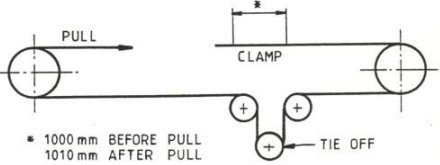No. of Plies |
Mass Thickness |
Belt Class |
|||||||||||
200 |
250 |
315 |
400 |
500 |
630 |
800 |
1000 |
1250 |
1600 |
2000 |
2500 |
||
2 |
All - kg/m2 |
3,3 |
3,8 |
4,8 |
4,9 |
6,3 |
6,3 |
- |
- |
- |
- |
- |
- |
3 |
All - kg/m2 |
4,4 |
4,4 |
5,4 |
5,0 |
5,0 |
5,5 |
7,6 |
7,6 |
- |
- |
- |
- |
4 |
All - kg/m2 |
|
|
6,2 |
6,2 |
7,0 |
7,0 |
7,1 |
10,3 |
10,3 |
- |
- |
- |
5 |
All - kg/m2 |
|
|
|
8,0 |
8,0 |
8,9 |
8,9 |
9,0 |
13,1 |
13,1 |
- |
- |
6 |
All - kg/m2 |
|
|
|
|
9,8 |
9,8 |
10,9 |
10,6 |
10,6 |
15,8 |
15,8 |
- |
????????????????????????????????
Table recommends take-up travel distance for Plylon fabric belts as a percentage of pulley center distance.
PLYLON
FABRICTYPE OF
TAKE-UPFASTENED SPLICE
VULCANISED SPLICE
100% of
Rated tension75% or less of
Rated Tension100% of
Rated Tension75% or less of
Rated TensionAll Nylon
Screw
Auto1,5%
2,0%1,0%
1,5%4,0%
2,5% + 0,6m3,0%
2,5% + 0,6mE.P.
Screw
Auto1,5%
1,0%1,0%
1,0%4,0%
1,5% + 0,6m3,0%*
1,5% + 0,6mNote:-
'*' Only short endless feeder belts and the like would normally be vulcanised on conveyors with screw take-up.Idler Spacing
Table indicates typical troughing idler spacing / pitch for various material bulk densities and belt widths
BELT WIDTH W (mm)
BULK DENSITY (tons/m3.)
Under 0,8
0,8 to 1,6
Over 1,6
600
750
900
10501,70
1,59
1,51
1,441,43
1,32
1,23
1,171,27
1,15
1,07
1,011200
1350
1500
1800
21001,40
1,35
1,31
1,24
1,191,12
1,08
0,04
0,98
0,930,97
0,93
0,90
0,84
0,80Transition Lengths

Table 1 indicates the recommended transition distance for half-troughed conveyor applications.
Table 2 indicates the recommended transition distance for full-troughed conveyor applications.
Table 3 indicates the number and location transition idlers.Table 1 - Transition distance for half-trough depth.
TROUGH ANGLE (deg.)
PERCENTAGE OF RATED TENSION
FABRIC BELTS
STEEL CABLE BELTS
20
MORE THAN 90
60 to 90
LESS THAN 600,9w
0,8w
0,6w2,0w
1,6w
1,0w35
MORE THAN 90
60 to 90
LESS THAN 601,6w
1,2w
0,9w3,4w
2,6w
1,8w45
MORE THAN 90
60 to 90
LESS THAN 602,0w
1,6w
1,2w4,0w
3,2w
2,2wNote:-
All conveyors using troughing idlers with angles greater than 20 adjacent to terminal pulleys shall have transition idlers between the given terminal pulley and the nearest standard idler.

Table 2 - Transition distance for full-trough depth.
TROUGH ANGLE (deg.)
PERCENTAGE OF RATED TENSION
FABRIC BELTS
STEEL CABLE BELTS
20
MORE THAN 90
60 to 90
LESS THAN 601,8w
1,6w
1,2w4,0w
3,2w
2,0w35
MORE THAN 90
60 to 90
LESS THAN 603,2w
2,4w
1,8w6,8w
5,2w
3,6w45
MORE THAN 90
60 to 90
LESS THAN 604,0w
3,2w
2,4w8,0w
6,4w
4,4wNote:-
All conveyors using troughing idlers with angles greater than 20 adjacent to terminal pulleys shall have transition idlers between the given terminal pulley and the nearest standard idler.Table 3 - Number and Location of transition idlers
NUMBER OF TRANSITION IDLERS
FIRST
SECOND
THIRD
FOURTH
1
0,33Y
2
0,17Y
0,50Y
3
0,10Y
0,30Y
0,60Y
4
0,07Y
0,20Y
0,40Y
0,67Y
Stringer Widths
Table indicates standard stringer widths for different belt widths.
BELT WIDTH
(mm)PULLEY FACE
WIDTH
(mm)STRINGER BOLT HOLE
CENTRE DISTANSESSTANDARD
RANGE
(mm)WIDE
RANGE
(mm)300
400
400
500
634
-
450
550
686
-
500
600
736
-
600
700
838
965
750
900
990
1118
900
1050
1144
1270
1050
1200
1296
1422
1200
1350
1448
1575
1350
1500
1600
1727
1500
1700
1752
1880
1650
1850
1904
2030
1800
2000
2058
2184
2100
2300
2362
2489
2400
2600
NOTE: This table agrees with the provisions of SABS 1313-1980 with respect to "standard" range centres only.
"Wide range" centres are not mentioned in this specification.


